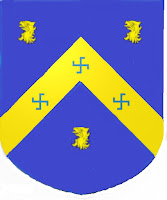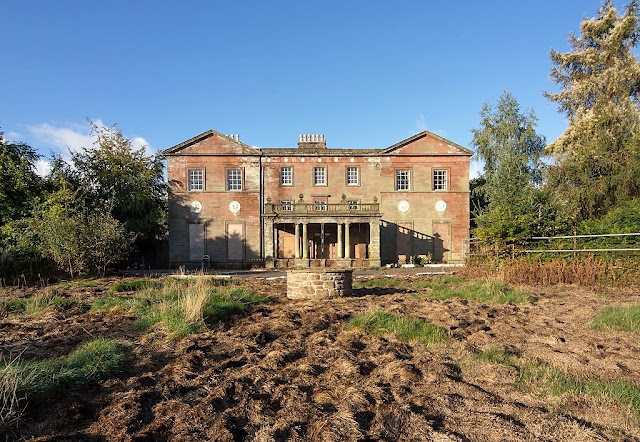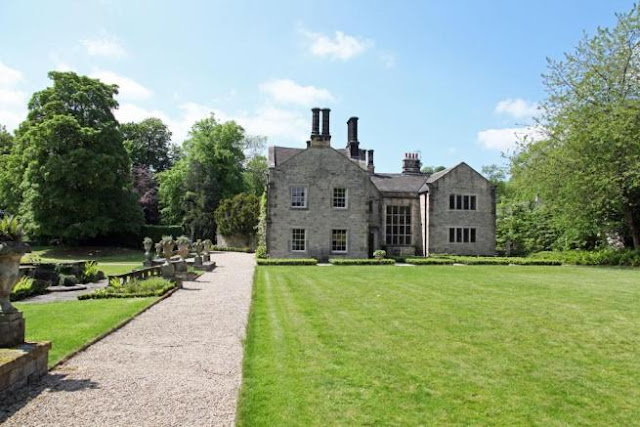 |
| Ashwin of Bretforton |
Bretforton Manor, Worcestershire
 |
| Bretforton Manor: the entrance front |
 |
| Bretforton Manor: panelling in the entrance hall |
After the house was sold by the Ashwin family it was stripped out and by 2000 a staircase and the panelling in the entrance hall had been stolen, although the panelling was subsequently recovered and reinstated. The house has since been thoroughly restored and the present owners have developed a notable 5-acre garden (occasionally open to the public) around the house to the designs of Paul Williams.
 |
| Bretforton Manor: side elevation. Image: JEH Photography |
Descent: William Ashwin (1738-1815); to son, John Ashwin (1760-1835); to son, James Ashwin (1806-60); to son, William Henry Ashwin (1835-92); to son, James Ashwin (1860-1941); to son, Harry Ashwin (1906-83); sold c.1984... to Derek Chapman; sold c.2000 to Joachim Franz Xavier Hettich (b. 1951); sold 2006 to Mr & Mrs. M.L. Chambers (fl. 2016).
Ashwin family of Bretforton
Ashwin, William (1738-1815). Son of James Ashwin (1710-1801) and his wife Mary Patten (d. 1763) of Bourton, baptised 27 July 1738. He married 1st, 11 August 1757, Elizabeth Sheppard (d. 1757) of Bretforton, and 2nd, 26 October 1758, Mary (c.1734-97), daughter of Richard Baldwin of Bretforton, and had issue including:
(2.1) James Ashwin (1760-1835) (q.v.);
(2.2) Richard Ashwin (1762-72), baptised at Bretforton, 6 January 1763; died young and was buried at Bretforton, 15 May 1772;
(2.3) Mary Ashwin (1766-1839?), baptised at Bretforton, 7 February 1766; married, 1 July 1788 at Bretforton, John Allen of Chipping Campden (Glos); probably the person of this name buried at Chipping Campden, 31 December 1839;
(2.4) Ann Ashwin (b. 1768), baptised at Bretforton, 29 January 1768;
(2.5) Theodosia Ashwin (b. 1771; fl. 1834); baptised at Bretforton, 16 May 1771; married, 1 June 1793 at Bretforton, John Joyner (d. 1803) of Broadway and had issue;
(2.6) William Ashwin (1773-1853), baptised at Bretforton, 6 January 1774; farmer at Broadway (Worcs); died 27 March 1853;
(2.7) Thomas Ashwin (1774-75), baptised at Bretforton, 4 December 1774; died in infancy and was buried at Bretforton, 6 January 1775;
(2.8) Sarah Ashwin (b. 1775/6; fl. 1834); baptised at Bretforton, 21 January 1776; married, 27 April 1795 at Bretforton, as his second wife, Richard Turner of Chipping Campden.
He inherited Bretforton Manor from his father in 1801. Through his second wife he 'inherited landed property of some importance' (the property which Nash in his Collections for the History of Worcestershire describes as being owned by Richard Baldwin).
He died 8 April and was buried at Bretforton, 11 April 1815. His first wife died 26 October 1757, just two and a half months after her marriage. His second wife died 23 April 1797 and was buried at Bretforton, 26 April 1797.
Ashwin, James (1760-1835). Son of William Ashwin (1738-1815) and his second wife Mary, daughter of Richard Baldwin of Bretforton, born 24 May and baptised 27 May 1760. He married 1st, 29 June 1784 at Sutton Coldfield (Warks), Kitty Anderton (d. 1796) of Sutton Coldfield, and 2nd, 3 December 1799 at Northleach (Glos), Rebecca (1782-1858), daughter of John Hall of Bretforton, and had issue including:
(1.1) Mary Ashwin (1785-88?), baptised 6 May 1785 at Bretforton; probably the person of this name buried at Bretforton, 3 February 1788;
(1.2) Ann Ashwin (1788-1822), baptised 24 January 1788 at Wickhamford; married, 8 January 1807 at Bretforton, John Hall (1783-1828) of Bretforton and had issue two sons and five daughters; buried at Bretforton, 13 May 1822;
(2.1) Kitty Ashwin (1801-66), baptised 31 December 1801 at Bretforton; married, 3 May 1823 at St Mary-de-Crypt, Gloucester, William Gough (d. 1865), farmer, of Hinton-on-the-Green (Glos, now Worcs) and had issue three sons and three daughters; died at Hinton-on-the-Green, 2 January 1866; will proved 3 July 1866 (effects under £3,000);
(2.2) Sarah Ashwin (1805-64), baptised 3 June 1805 at Bretforton; lived with her widowed mother in Bretforton until her mother's death in 1858 and then moved to Tivoli Cottage, Cheltenham, where she died unmarried, 26 March 1864; will proved 20 April 1864 (effects under £200);
(2.3) James Ashwin (1806-60) (q.v.);
(2.4) Helen Ashwin (1809-74), baptised 18 October 1809 at Bretforton; married, 25 September 1834 at Bretforton, Henry Collins of Duffryn House (Monmouths.), farmer, and had issue three sons and five daughters; died at 2 Park Place, Cheltenham, 7 January 1874; will proved 17 January 1874 (effects under £800);
(2.5) Richard Ashwin (1811-66), baptised 10 October 1811; farmed at Aldington (Worcs); married 1st, 15 December 1840 at St Lawrence, Evesham (Worcs), Ann (1821-42), daughter of Anthony New of Evesham (Worcs) and had issue one son (who died in infancy); married 2nd, 5 October 1843 at St Lawrence, Evesham, Mary Louisa Harriet (1820-61), youngest daughter of John Wesney Lavender, esq.; died 30 May 1866; will proved 20 June 1866 (effects under £4,000);
(2.6) Emma Ashwin (1812-60), baptised at Bretforton, 3 January 1813; married, 20 May 1834 at Bretforton, Oswald Cheek (d. 1868), Town Clerk of Evesham (Worcs) and had issue seven sons and five daughters; died 3 May and was buried at Evesham, 9 May 1860;
(2.7) Rebecca Ashwin (c.1814-43), born about 1814; married, 14 January 1835 at Bretforton, William Williams of Newport (Monmouths.), banker, son of William Williams esq. of Newport; died 'after a short but severe illness', 24 April 1843;
(2.8) Caroline Ashwin (1816-86), baptised at Bretforton, 10 November 1816; married, 8 January 1839 at Bretforton, Charles Randell (d. 1888) of Chadbury (Worcs); died Jan-Mar 1886;
He inherited the Bretforton Manor estate from his father in 1815.
He died 12 May 1835; his will was proved in the PCC, 18 July 1835. His first wife died 25 February and was buried at Bretforton, 28 February 1796. His widow died 27 October 1858; her will was proved 30 April 1859 (effects under £200).
Ashwin, James (1806-60). Son of James Ashwin (1760-1835) and his second wife Rebecca, daughter of John Hall of Bretforton, born 28 November 1806 and baptised 20 May 1807. JP and DL for Worcestershire; churchwarden of Bretforton, 1831-34. He married, 19 January 1831 at Bassaleg (Monmouths.), Jane (1805-79), daughter of John Donne Collins of Duffryn (Monmouths) and had issue:
(1) Clara Anne Ashwin (1832-1904), born 25 July 1832; married, 13 October 1855 at Bretforton, Adam Eyton JP (1825-1900) of Plas Llanerchymor (Flints) and had issue three sons and three daughters; died 22 May 1904; will proved 7 November 1911 (estate £1,066);
(2) Lt. James Collins Ashwin (1833-55), born 9 September 1833; Lt. in 57th Foot; killed before Sebastopol in the assault on the Great Redan, during the Crimean War, 18 June 1855;
(3) William Henry Ashwin (1835-92) (q.v.).
He inherited the Bretforton Manor estate from his father in 1835.
He died 9 May 1860 and was buried at Bretforton, where he is commemorated by a monument in the chancel; his will was proved 6 July 1860 (effects under £7,000). His widow died in Cheltenham, 1 December 1879; her will was proved 22 December 1879 (effects under £450).
Ashwin, William Henry (1835-92). Second son of James Ashwin (1806-60) and his wife Jane, daughter of John Donne Collins of Duffryn (Monmouths.), born 11 March and baptised at Bretforton, 7 April 1835. Educated at Exeter College, Oxford (matriculated 1854). JP for Worcestershire and DL for Gloucestershire and Worcestershire. For a possible portrait of W.H. Ashwin see the end of this post. He married, 21 September 1858, Gwenelin (1836-1924), daughter of J. Prys Eyton of Plas Llanerchymor (Flints) and had issue:
(1) Amy Ashwin (1859-1952), born 2 June 1859; married, 28 September 1881, John Henderson (d. 1930) of Clifton (Derbys), and had issue one son and three daughters; died 30 April 1952 and was buried at Clifton, 5 May 1952; will proved 21 June 1952 (estate £771);
(2) James Ashwin (1860-1941) (q.v.);
(3) Maud Ashwin (1862-96), born 17 March 1862; married, 28 September 1881 at Bretforton, Rev. Belton Young (1856-1935), son of Richard Young MP of Walsoken (Norfk) and had issue two daughters; died at Ventnor (IoW), 31 March 1896; commemorated by a stained glass window in Bretforton church;
(4) Lt. Henry Ashwin (1863-87), born 17 June 1863; Lt. in the Royal Navy; died unmarried, 29 November 1887;
(5) Clara Ashwin (1865-1948), born 28 January 1865; married, 30 April 1889, John Faulkner JP (1865-1941) of Kempsford (Glos), eldest son of William Carey Faulkner of Charlton House (Worcs), but had no issue; died at Barnwood House Hospital, Gloucester, 2 March 1948; will proved 18 August 1948 (estate £2,044);
(6) Richard Ashwin (1866-1938), born 18 December 1866 and baptised at Bretforton, 17 March 1867; educated at Royal Medical Benevolent College; died unmarried, 21 July 1938;
(7) Keyt Ashwin (1868-1952), born 1 July 1868; officer in the merchant navy, 1885-1902 (mate, 1891; master, 1898); Lt. in Royal Navy Reserve 1898-1918; died unmarried, 20 February 1952; will proved 22 April 1952 (estate £15,436);
(8) Rev. Collins Ashwin (1870-1938), born 17 March 1870; educated at Merton College, Oxford (matriculated 1889; BA 1892; MA 1896); ordained deacon, 1897 and priest, 1898; curate of Wimborne Minster (Dorset), 1897-99; vicar of Stanway (Glos), 1899-1904; rector of Dumbleton (Glos), 1904-38 (with Wormington from 1912); rural dean of Winchcombe, 1920-23; married, 6 April 1899 at Moor Allerton, Gertrude (d. 1901), third daughter of George Watson of Donisthorpe House, Moor Allerton (Yorks) and had issue two sons; died 12 November and was buried at Stanway, 15 November 1938; will proved 22 December 1938 (estate £676);
(9) Gwenelin Ashwin (1872-98), born 17 January and baptised 16 July 1872; died unmarried at Territet (Switzerland), 19 February 1898;
(10) Marion Ashwin (1874-1962), born 22 December 1874; married, 9 February 1902 in St Paul's Cathedral, Calcutta (India), Arthur William Watson CB CBE (d. 1925), senior civil servant, son of Dr. James Watson, and had issue; died 24 February 1962; will proved 30 May 1962 (estate £1,395);
(11) Clinton Ashwin (1873-1932), born 12 August 1873; joined the merchant navy, 1891; died unmarried, 27 August 1932;
(12) Hildegarde Ashwin (1879-1969), born 30 October 1879; married, 31 January 1903, Herbert Henry Ryland (1872-1958), solicitor, son of Henry Skipper Ryland, Master of the Supreme Court, and had issue; died 25 February 1969.
He inherited the Bretforton Manor estate from his father in 1860 and largely rebuilt the manor house in the 1870s.
He died 21 February 1892; his will was proved 31 May 1892 (effects £2,173). His widow died 14 November 1924; her will was proved 22 December 1924 (effects £127).
Ashwin, James (1860-1941). Eldest son of William Henry Ashwin (1835-92) and his wife Gwenelin, daughter of J. Prys Eyton of Plas Llanerchymor (Flints), born 15 July 1860. Educated at Eton. JP and DL for Worcestershire and JP for Gloucestershire; High Sheriff of Worcestershire, 1914. County Councillor and later County Alderman for Worcestershire. He married, 19 November 1890, Clara (1868-1946), eldest daughter of George Watson, soap manufacturer, of Donisthorpe House, Moor Allerton (Yorks) and sister of 1st Baron Manton, and had issue:
(1) Thetis Mary Ashwin (1891-1981), born 12 October and baptised at Moor Allerton, 5 December 1891; lived at Manor Farm, Bretforton; died unmarried, 29 July 1981; will proved 6 November 1981 (estate £128,278);
(2) Ruth Ashwin (1893-1969), born 31 October 1893; married, 16 October 1924, Alfred Eric Lawrence Craven (1894-1987) of Ditcheat (Somerset), younger son of Hiram Craven of The Briery, Sunderland (Durham) and had issue one son and two daughters (one of whom inherited the Bretforton estate in 1983 on the death of her uncle; and sold up); died 22 May 1969; will proved 29 September 1969 (estate £19,499);
(3) James Ashwin (1897-1907), born 30 April 1897; died young of appendicitis, 3 September 1907;
(4) Charles Watson (k/a Bobbie) Ashwin (1902-32), born 26 November 1902; educated at Eton; described by James Lees-Milne as "the good-looking, fragrantly pansy brother"; died unmarried in the lifetime of his father as a result of a fractured skull sustained in a motor accident in London, 21 April 1932;
(5) Henry Ashwin (1906-83) (q.v.);
(6) Clara Ashwin (1908-45), born 17 June 1908; described by James Lees-Milne as "tall and plain, with a dry sense of humour"; married, 1 August 1933, Charles Frederick Rex Bagnall CBE (1904-93) of Cerne Abbas (Dorset) and had issue two sons; died of tuberculosis 'brought on by war work', 4 October 1945; will proved 12 March 1946 (estate £9,935).
He inherited the Bretforton Manor estate from his father in 1892. In the period 1893-1910 he seems to have leased the pretty Gothick village house, Bretforton Hall, and to have lived there, presumably while his mother remained in the Manor.
He died 8 July 1941; his will was proved 9 January 1942 (estate £54,287). His widow died 17 May 1946; her will was proved 11 September 1946 (estate £7,433).
Ashwin, Henry (k/a Harry) (1906-83). Youngest but only surviving son of James Ashwin (1860-1941) and his wife Clara, eldest daughter of George Watson of Donisthorpe House, Moor Allerton (Yorks), born 9 October 1906. Educated at Eton and Magdalene College, Cambridge (BA 1928). JP and DL for Worcestershire; High Sheriff of Worcestershire, 1954; served on Worcestershire County Council (councillor, 1934; alderman, 1952; Vice-Chairman, 1961-67). Served in Second World War in Royal Artillery, 1939-40 and RAF Volunteer Reserve, 1940-45 (Sq Ldr, 1944). According to his childhood companion, James Lees-Milne "he was always deadly dull, a lump". He was unmarried and without issue.
He inherited the Bretforton Manor estate from his father in 1941. In the 1950s he sold several of the farms and later many of the cottages in the village as they became vacant. After his death the remainder of the estate passed to one of his nieces and was sold up.
He died 8 June 1983; his will was proved 15 September 1983 (estate £1,180,137).
Sources
Burke's Landed Gentry, 1972, pp. 29-30; M. Bloch (ed.), James Lees-Milne: diaries 1971-83, passim; A. Brooks & Sir N. Pevsner, The buildings of England: Worcestershire, 2007, p. 171.
Location of archives
Ashwin family of Bretforton: deeds, wills, plans, estate and family papers, 1562-20th cent. [Worcestershire Archive & Archaeology Service, 705:273]
Coat of arms
Argent, on a chevron between three kites' heads erased or, as many fylfots of the field.
Can you help?
Here are a few notes about information and images which would help to improve the account above. If you can help with any of these or with other additions or corrections, please use the contact form in the sidebar to get in touch.
- If anyone is able to provide additional career information, genealogical details or portraits for this family, I should be very pleased to hear from them.
























